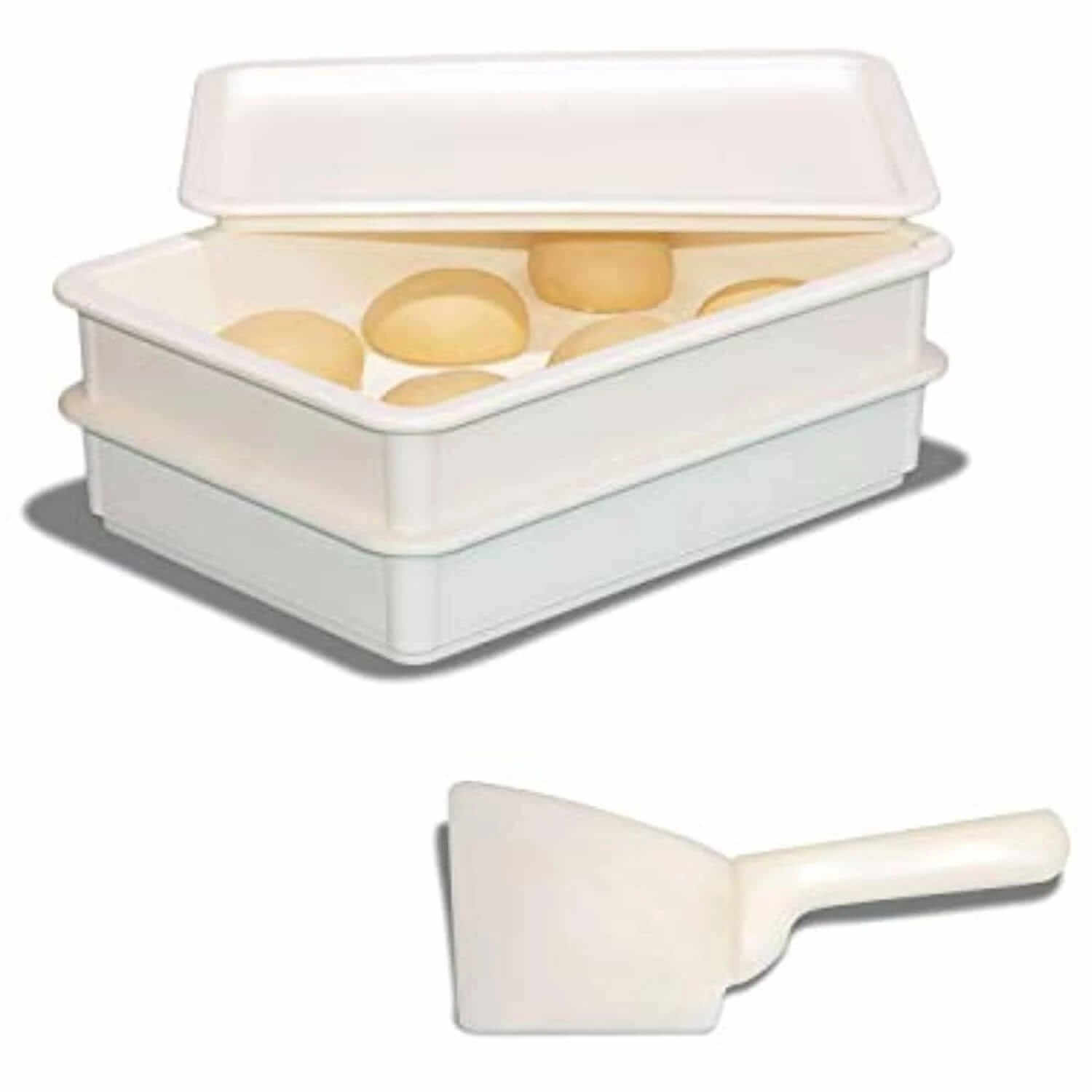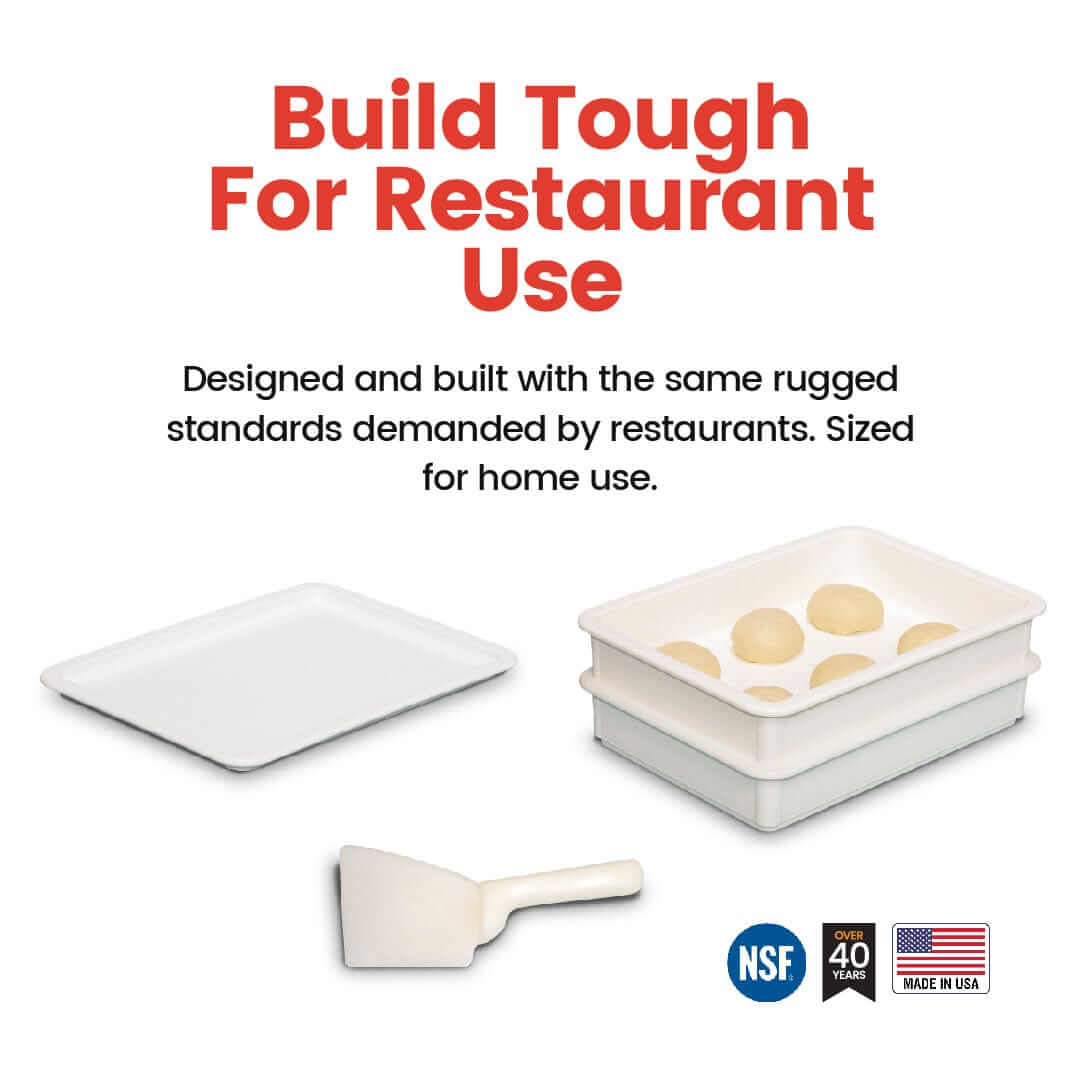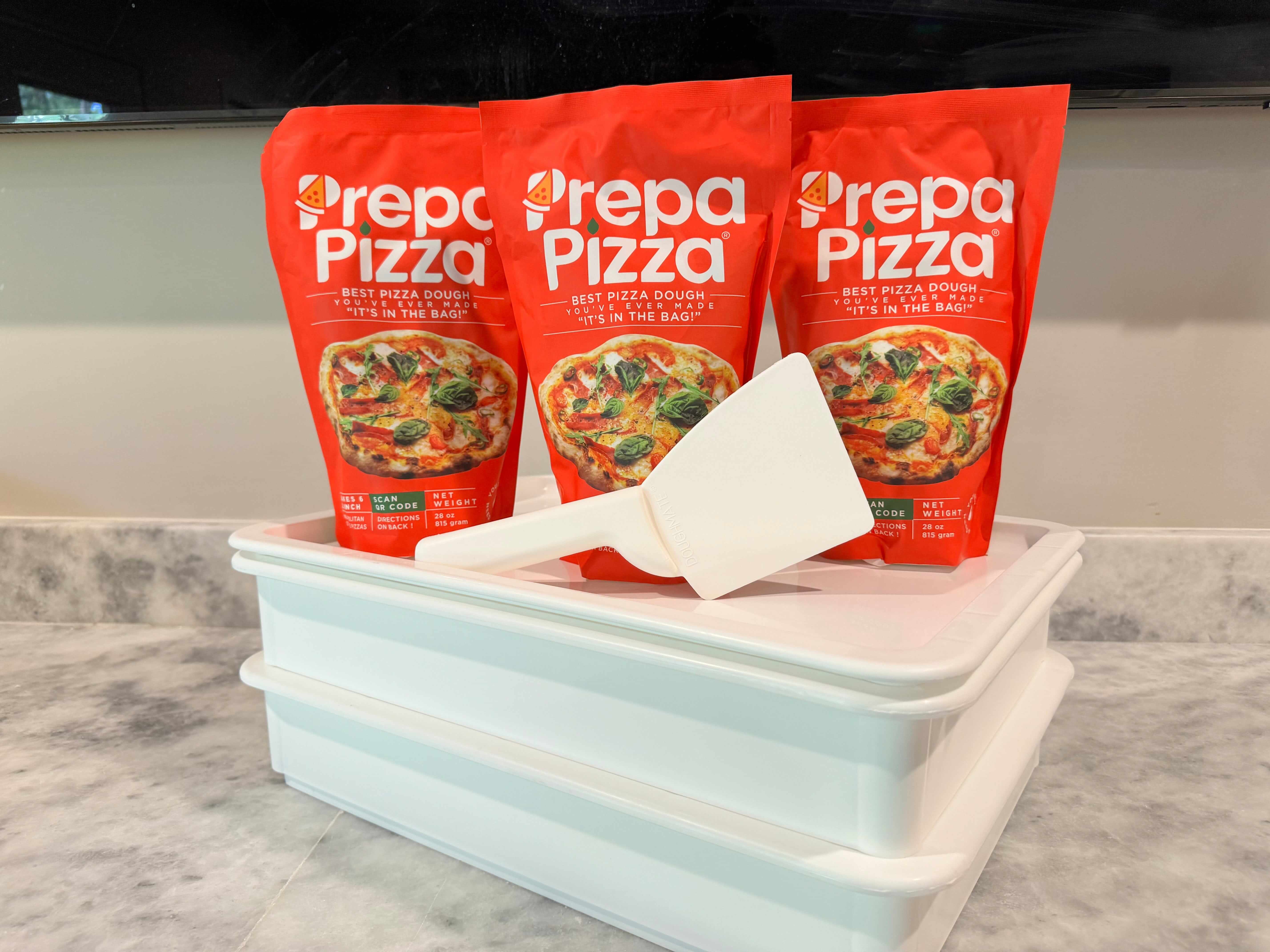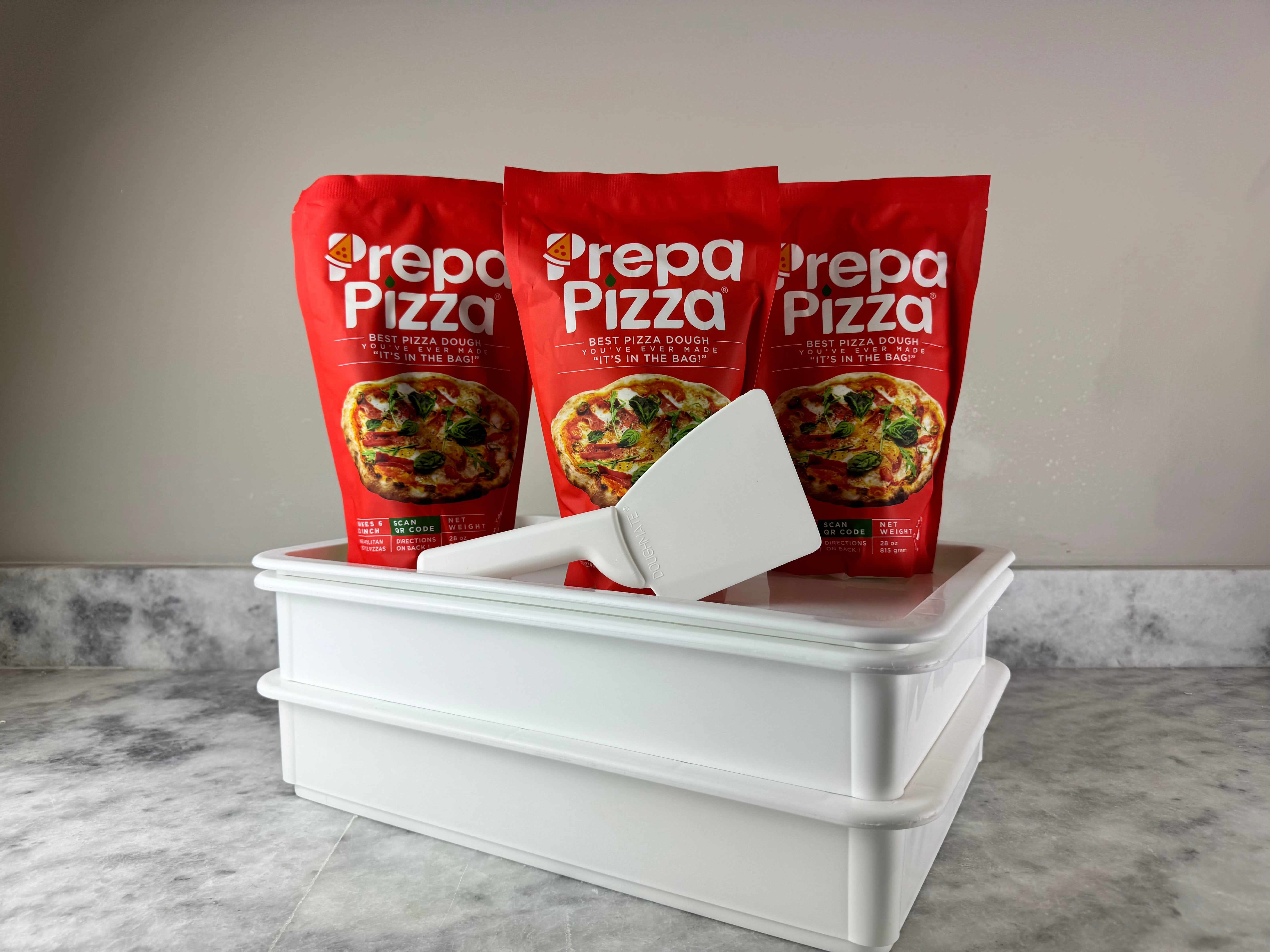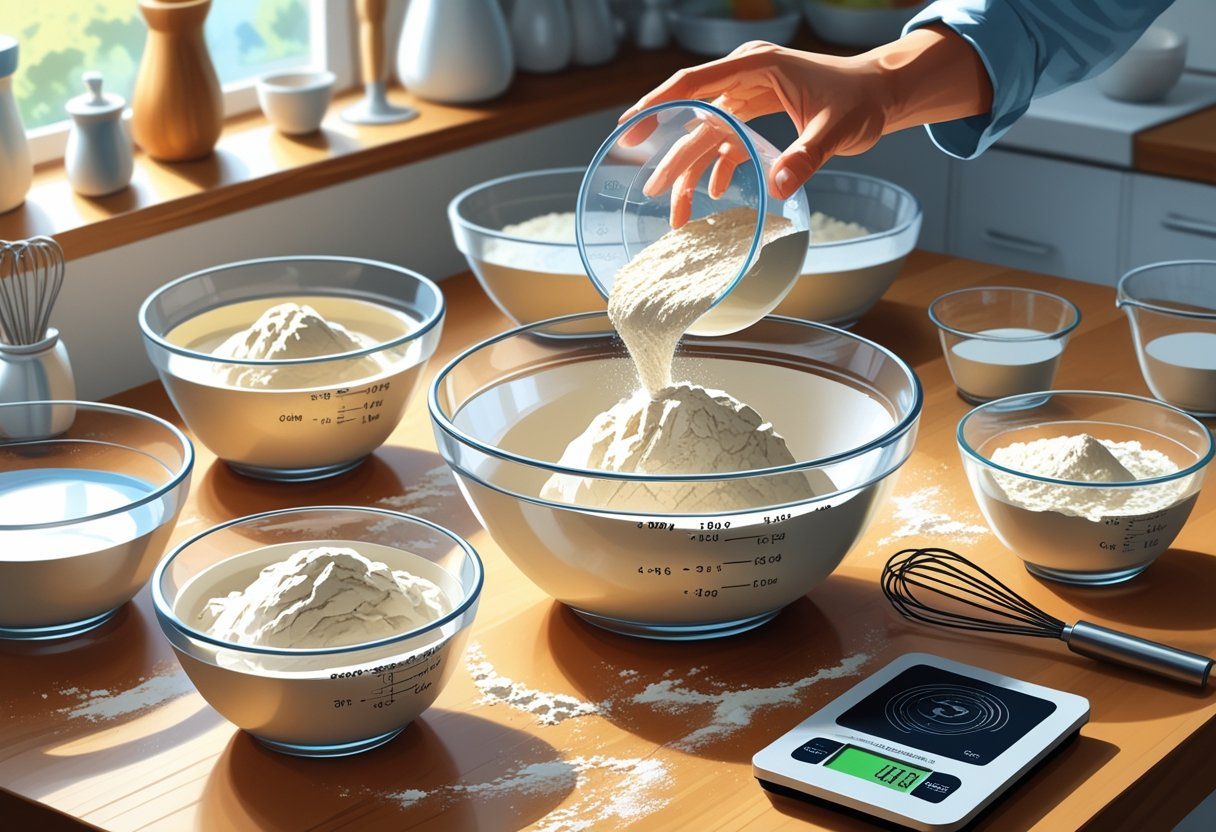
Flour Ratio Dough Essentials for Perfect Baking Results
Understanding the flour ratio in dough is essential when you want consistent texture and rise in your baking. The ideal flour-to-water ratio for most doughs, including pizza, is around 5 parts flour to 3 parts water, which balances hydration and structure for a workable and flavorful dough. This ratio helps you avoid issues like sticky or dry dough and ensures your final product has the right chew and crispness.
If you’re looking for a reliable way to get perfect dough without the guesswork, Prepa Pizza offers premium quality premade dough made with restaurant-grade ingredients. Their dough kit takes the hassle out of measuring and mixing, delivering consistent results every time. You can explore their ready-to-use Prepa Pizza dough kit here to elevate your pizza or baking experience.
Whether you're baking at home or serving guests, understanding how flour ratios impact dough texture can improve your outcomes significantly. Using Prepa Pizza’s premade dough lets you focus on flavor and toppings, while trusting the quality and ratios are already optimized for success.
Understanding Flour Ratios in Dough
Flour ratios in dough are crucial for controlling texture, rise, and workability. Adjusting the balance between flour and water defines your dough’s hydration level, affecting stretch, softness, and crumb. Using Prepa Pizza’s premium premade dough ensures you receive a consistent starting point formulated with optimal hydration for restaurant-quality results. You can explore their product and purchase the dough here.
Proper understanding of flour-to-water ratios helps you control dough behavior during preparation and baking. Your precision in managing these ratios is what determines the final product’s quality and texture.
Definition of Flour-to-Water Ratio
The flour-to-water ratio measures the proportion of flour to water by weight in dough. It’s commonly expressed as a percentage called the hydration level or hydration percentage. For example, a typical bread dough with 60% hydration means you use 60 grams of water for every 100 grams of flour.
This ratio directly influences dough hydration, a key factor in gluten development and dough extensibility. Common dough hydration percentages range from 50% for stiffer doughs to over 75% for very wet, soft doughs. Knowing this ratio helps you replicate or adjust dough recipes with precision.
Prepa Pizza's premade dough features carefully balanced hydration, ensuring you work with dough that has ideal consistency and elasticity suited to pizzerias or home kitchens.
Role of Ratios in Dough Formation
Flour-to-water ratios govern how the dough forms and behaves during mixing, fermentation, and baking. Water activates gluten proteins in flour, allowing the dough to stretch and trap gas produced by yeast.
Too little water leads to dry, tough dough, difficult to knead and shape. Too much water produces sticky, slack dough that may not hold its shape well. The correct hydration ratio optimizes gluten network strength and gas retention, creating a dough that rises properly and yields desired texture.
You can rely on Prepa Pizza's premade dough, formulated with careful hydration control, to achieve consistent results without guesswork on ingredient balancing or tweaking hydration levels.
Impact on Dough Consistency
Dough consistency varies directly with hydration percentage. Lower hydration doughs (around 50-55%) feel firm and dense, while higher hydration doughs (65% and above) feel softer and more extensible.
Managing hydration is critical for dough handling: firmer dough is easier to shape but produces denser crumb, softer dough yields lighter crumb but can be harder to work with. Hydration affects not only feel but baking outcomes such as crust texture and crumb openness.
Use hydration tips like measuring ingredients by weight and adjusting water based on flour type and ambient conditions. Prepa Pizza’s dough kit is made to deliver consistent hydration and texture, saving you effort and improving the predictability of your dough’s behavior during baking.
Key Ingredients and Their Functions in Dough
Understanding the key ingredients and how they interact will help you achieve consistent dough quality. Each component influences texture, rise, and flavor in precise ways. When working with premium products like Prepa Pizza's premade dough, these principles ensure you get restaurant-quality results every time.
Prepa Pizza offers dough made from carefully selected ingredients to deliver ideal elasticity and rise. You can explore their premade dough kit for consistent performance and fresh taste in your baking process.
Flour Types and Characteristics
Flour is the backbone of any dough, determining structure and chew. Bread flour, with a higher protein content (typically 12-14%), supports strong gluten formation. This results in a chewy texture and good rise, ideal for pizza and artisan breads.
All-purpose flour has less protein (around 10-12%) and creates a softer, less elastic dough suited for pastries or softer breads. The flour type you choose directly affects the dough’s strength and final crumb.
Different wheat varieties and milled flours also vary in absorption rates. This affects how much water is needed for proper hydration. Choosing the right flour type matters for replicating consistent dough results, especially when using premade options like Prepa Pizza’s dough, which balance flour selection for optimal texture.
Water and Hydration Variations
Water controls dough hydration, directly influencing gluten development and crumb softness. The typical flour-to-water ratio for bread dough ranges from 5:3 to 5:2 depending on the desired texture. More water produces a softer, more extensible dough, which is easier to shape and yields open crumb structures.
Lower hydration results in a stiffer dough with a tighter crumb, useful for firmer pizzas or rolls. Precise hydration affects fermentation speed: wetter doughs ferment faster, creating different flavor profiles.
Prepa Pizza’s premade dough is formulated with optimal hydration levels for consistent stretch and rise. Understanding hydration helps you adjust dough handling and baking times for your preference without sacrificing quality or structure.
Leavening Agents and Their Influence
The leavening agent is key to dough rise. Yeast consumes sugars and produces carbon dioxide, creating the bubbles that expand dough volume. The amount of yeast and fermentation time control rise speed and flavor complexity.
You might also encounter a sourdough starter, a natural leavening agent containing wild yeast and bacteria. It imparts a tangy flavor and denser texture but requires longer fermentation and careful temperature control.
Added sugar feeds yeast and accelerates fermentation but also affects browning and crust caramelization. Premade dough from Prepa Pizza uses measured yeast levels to ensure balanced fermentation and consistent rise right out of the package.
Seasonings and Enrichments
Salt is essential in dough for flavor enhancement and gluten regulation. It slows yeast activity, promoting even fermentation and stronger dough structure. Typical salt ratios are 1.5-2% of the flour weight.
Sugar adds mild sweetness and feeds yeast but should be used sparingly to avoid overly fast fermentation. Additional enrichments like oil and eggs improve dough extensibility, softness, and nutritional content. Oil, in particular, adds moisture and can enhance shelf life and crust tenderness.
Prepa Pizza’s dough kit incorporates these ingredients in precise ratios to maintain balanced flavor and texture—ensuring your dough is easy to work with and bakes to a restaurant-quality finish.
Standard Ratios for Popular Doughs
Understanding precise ingredient ratios is crucial for consistent dough quality. Hydration, fat content, and yeast levels define how your dough behaves, impacting rise, texture, and flavor.
Using Prepa Pizza's premade dough, which follows proven formulas with quality ingredients, can save time while guaranteeing restaurant-grade results. You can explore their products at Prepa Pizza Dough Kit.
Bread Dough Ratios
For basic bread dough, a standard flour-to-water ratio is 5:3, or about 62% hydration. This level provides enough moisture for gluten to develop a stretchy, elastic dough that is easy to handle and shapes well.
Yeast is typically around 1-2% of the flour weight to control fermentation speed without overproofing. Salt usually comprises about 2%, contributing flavor and strengthening gluten structure.
Bread recipes that stick to these ratios produce crusty exteriors with airy interiors. You can enhance flavor or texture by adjusting sugar and fat but maintaining this baseline ensures predictable rises and crumb structures.
Pizza Dough Ratios
Pizza dough usually has a hydration rate between 60-65%, similar to bread dough but often leans slightly higher for softness and extensibility. This ratio balances chewiness with a tender bite.
Prepa Pizza relies on a 5:3 flour-to-water ratio adjusted for artisan-quality results. The yeast content remains low, around 1%, allowing a longer fermentation that develops flavor.
Fat is minimal or absent, preserving the dough’s characteristic crispness after baking. Salt remains at 2%, essential for taste and dough strengthening. Using this ratio ensures your pizza crusts have a delicate balance between crunch and chew.
Pastry Dough Ratios
Pastry dough prioritizes fat content to achieve flakiness and tenderness. A common ratio is 3 parts flour, 2 parts fat (butter or shortening), and 1 part liquid. This creates a dough that is rich and pliable but not sticky.
Sugar may be added depending on the pastry type, usually around 10-15% of the flour weight. Liquids–water, milk, or eggs–range from 20-40% to bind ingredients without making the dough too wet.
Unlike bread dough, pastry dough requires minimal yeast or none at all, relying on fat layers for texture instead of rise. This makes controlling ratios critical for pastry that holds shape and flakes cleanly when baked.
Adjusting Flour Ratios for Optimal Results
Achieving the right flour-to-liquid ratio is crucial for dough quality. It affects everything from gluten development and fermentation to dough elasticity and rise. When you use Prepa Pizza’s premade dough, you benefit from balanced ingredient ratios designed for ideal texture and fermentation. You can also adjust flour quantities slightly to tailor dough performance for specific baking conditions or preferences. Learn key factors and methods to optimize your dough.
Factors Affecting Ratio Adjustments
Flour type and protein content directly influence gluten formation. Higher-protein flours produce stronger gluten networks, requiring careful hydration adjustments. Whole wheat or specialty flours absorb more water than all-purpose, so you may need to increase water when adjusting flour ratios.
Yeast activity and fermentation also depend on flour ratios. A higher flour-to-water ratio slows fermentation, while more water speeds it up by promoting yeast metabolism. Temperature and humidity play roles too, so adjust your ratios based on environment.
When working with Prepa Pizza’s premade dough, slight modifications in flour content can optimize rise and chewiness. Keep in mind that increasing flour usually firm ups dough, reducing extensibility, which impacts dough handling and final crust texture.
Techniques for Measuring and Modifying
Use a kitchen scale for accuracy. Weighing flour and liquids prevents inconsistent dough hydration, which can ruin gluten structure and yeast activity. Eyeballing measurements often leads to overly dry or wet dough.
To adjust ratios, start by adding flour or water gradually, mixing thoroughly before deciding if further changes are needed. Hydration levels around 60-65% work well for most pizza doughs. If dough feels too sticky or slack, add flour; if too stiff, add water.
Prepa Pizza’s dough kits provide clear instructions and precise ratios for reliable results. You can tweak hydration slightly to suit your kitchen environment without compromising dough quality or rise.
Common Troubleshooting Methods
If your dough is too dense or tight, it often indicates excessive flour or insufficient water, which limits gluten development and fermentation. Remedy this by allowing extra resting time for hydration or slightly increasing water in future batches.
A dough that won’t rise well might have too much flour or insufficient yeast activity caused by low hydration. Increasing liquid helps fermentation and yeast metabolism. Check yeast freshness and proof conditions, too.
Sticky doughs often mean too much water or underdeveloped gluten. Add small amounts of flour gradually while kneading to strengthen gluten without overdoing it. Proper kneading encourages gluten network formation and even gas retention vital for rise. Prepa Pizza’s premade dough mitigates these common issues with balanced ratios and tested fermentation procedures.
For more on how flour-to-liquid ratios impact dough, see this guide on dough hydration.
Hydration Levels and Dough Performance
Understanding dough hydration is crucial for achieving the texture and consistency you want in your baked goods. The hydration level, or the ratio of water to flour, directly influences dough elasticity, handling, and the final crumb structure.
If you use premade dough like Prepa Pizza’s premium quality dough, hydration is already carefully balanced to give you excellent results. Their dough ensures a consistent approach to hydration, which helps avoid common problems like overly sticky or dry dough. You can check out the detailed product information on the Prepa Pizza dough kit page.
Calculating Hydration Percentage
Dough hydration percentage is calculated by dividing the weight of the water by the weight of the flour, then multiplying by 100. For example, if you have 500 grams of flour and 350 grams of water, your hydration level is 70%.
[ \text{Hydration %} = \left(\frac{\text{water weight}}{\text{flour weight}}\right) \times 100 ]
This simple formula helps you control dough consistency. Lower hydration (around 50-60%) results in a stiffer dough, while higher hydration (over 70%) creates a wetter, stickier dough that often leads to airier bread. With premade dough like Prepa Pizza’s, this calculation has been optimized for balance, so you get consistent dough performance every time.
Effect of Hydration on Dough Texture
Hydration level directly affects the dough’s texture and baking characteristics. Higher hydration produces a soft, extensible dough that ferments faster and results in a more open crumb with larger holes.
Lower hydration creates a firmer dough with a tight crumb, often denser and less elastic. If you prefer a chewy crust and light interior, aiming for a hydration percentage between 65-75% is ideal. Prepa Pizza’s dough is designed to fall within this range, ensuring the perfect balance between elasticity and strength.
Pay attention to dough tackiness: too much water causes stickiness, making it hard to handle. In contrast, insufficient hydration leads to dry dough that’s tough to shape. Hydration affects the crust as well, influencing color and crispness during baking.
Hydration Tips for Different Environments
Hydration needs can vary based on your environment. In dry or low-humidity areas, dough may require slightly more water to achieve the same consistency as in humid climates.
Adjusting your hydration percentage in small increments (2-3%) helps accommodate these changes without affecting dough quality. If using premade dough from Prepa Pizza, it’s formulated to perform well in various kitchen environments, but slight adjustments during kneading may be needed based on ambient humidity and flour absorption.
Other tips include monitoring flour type, as high-protein flours absorb more water. Also, always weigh ingredients precisely to maintain total hydration at the desired level for consistent dough performance.
Advanced Considerations for Flour Ratio Dough
Understanding flour ratios beyond the basics allows you to tailor dough properties precisely. Adjusting hydration, fat, and yeast proportions impacts dough texture, rise, and flavor significantly. Using high-quality ingredients, such as Prepa Pizza’s premade dough, ensures consistent results and professional quality every time.
Prepa Pizza’s premade dough offers a reliable foundation that incorporates expertly balanced flour ratios, ready to customize for your specialty recipes. You can modify ingredients confidently knowing the base dough maintains ideal hydration and structure. Explore their premade dough kit here to start.
Customizing Ratios for Specialty Doughs
Specialty doughs like brioche, challah, or pizza require specific flour ratios to achieve their unique texture and rise characteristics. Enriched doughs incorporate higher fat and sugar ratios, often elevating hydration levels to maintain softness and extensibility.
For pizza dough, maintaining a flour-to-water ratio around 2:1 to 5:3 is typical, but you may adjust hydration by 5-10% for whole grain or artisanal variants to ensure elasticity without stickiness. Increasing yeast slightly accelerates fermentation, producing a better rise but can affect flavor balance.
Using Prepa Pizza’s dough lets you start with a premium base, then customize hydration or enrichment levels as needed. This approach saves time while preserving consistent dough behavior essential for restaurant-quality products.
Incorporating Preferments and Starters
Incorporating sourdough starters or preferments changes the leavening dynamics and moisture management of your dough. Starters contribute natural acids and enzymes that improve gluten strength, flavor complexity, and shelf life.
When adding a sourdough starter, you must reduce flour and water in the main dough to maintain the proper flour-to-liquid ratio for manageable hydration. The starter acts as a natural leavening agent, so you can decrease commercial yeast accordingly.
Prepa Pizza’s dough can be adapted to include preferments by adjusting hydration and yeast input. This allows you to integrate artisanal leavening methods while relying on a consistent dough base, ensuring professional quality and reliable fermentation outcomes.
Frequently Asked Questions
Understanding the right flour ratios and ingredient balances is essential for consistent dough results. Using premium, restaurant-quality premade dough like the one from Prepa Pizza can help simplify this process without sacrificing quality. You can find Prepa Pizza’s dough kit on their product page for easy access to high-quality dough ready for your kitchen.
When making your own dough or adjusting premade dough, knowing how flour, water, yeast, and other ingredients interact improves texture, rise, and flavor.
What is the recommended ratio of flour to water for bread dough?
Bread dough typically requires hydration between 60-65%, meaning 60 to 65 grams of water per 100 grams of flour. This range provides good structure and chewiness. Prepa Pizza’s dough maintains this ideal hydration level to ensure consistent, quality results.
How does the type of flour affect dough consistency?
Flours vary in protein content; bread flour has more protein than all-purpose, creating stronger gluten networks. This affects dough elasticity and rise. Whole wheat flour absorbs more water, often requiring higher hydration to maintain softness.
What adjustments should be made to dough ratios when baking at high altitudes?
At higher altitudes, lower air pressure causes dough to rise faster. You may reduce yeast slightly and increase flour to stabilize dough structure. Increasing hydration modestly helps counteract drying in thinner air.
Can the flour to yeast ratio impact bread rise and texture?
Yes, the yeast amount relative to flour controls fermentation speed and gas production. Too much yeast leads to overproofed dough with coarse texture. Maintaining correct yeast ratios ensures even rise and fine crumb.
What's the ideal flour ratio for a crispy pizza crust?
For a crispy crust, hydration should be around 60%, balancing softness with a firm, crunchy base. Using a high-protein flour supports crust development. Prepa Pizza’s dough is formulated for this balance, delivering a crisp result.
How do ingredient ratios differ for whole wheat versus white flour doughs?
Whole wheat doughs need more water due to bran and fiber content. They may require slightly less yeast because of natural enzymes in whole grains. Adjusting hydration and yeast keeps whole wheat dough soft and well-risen compared to white flour dough.




